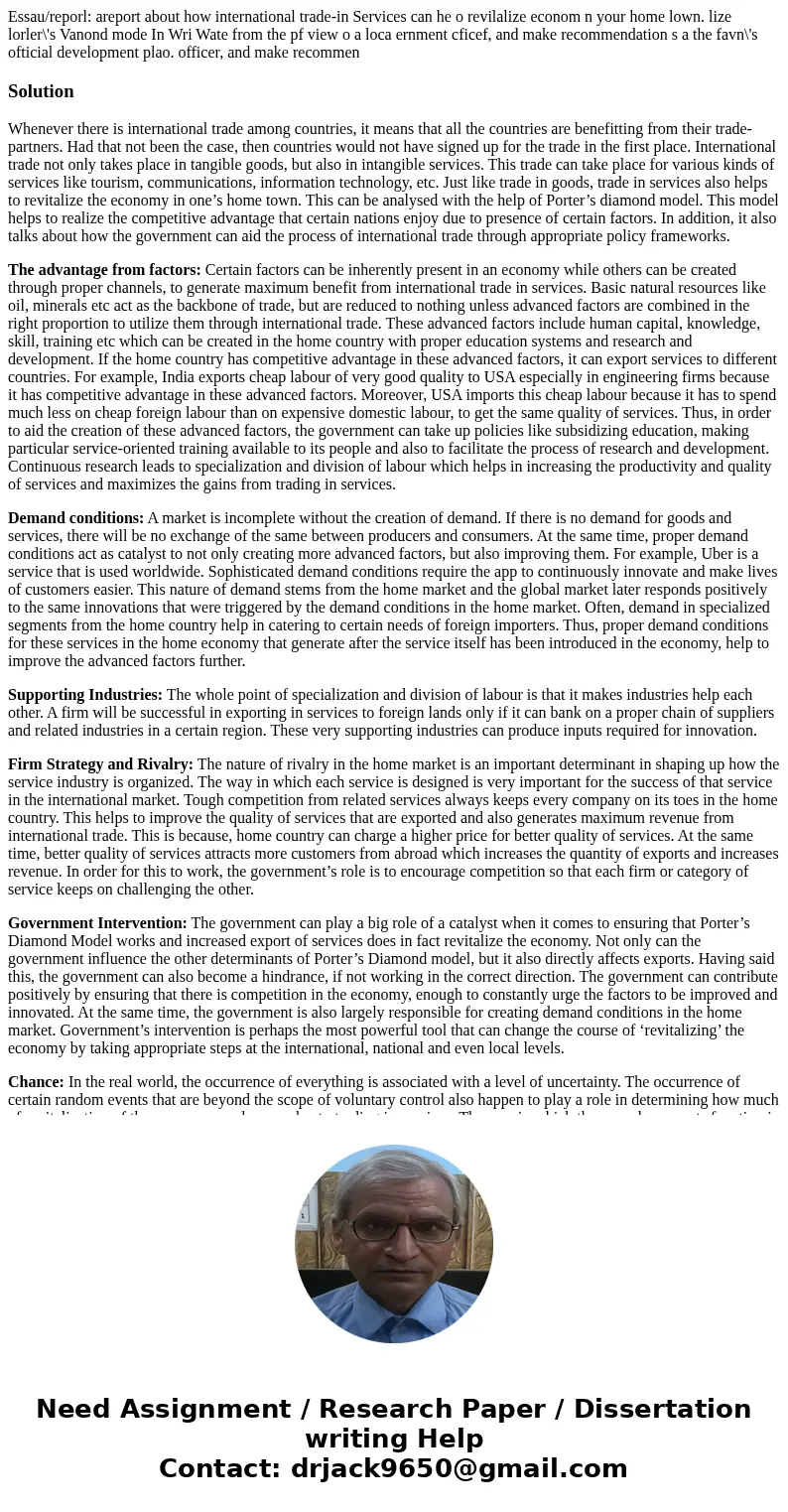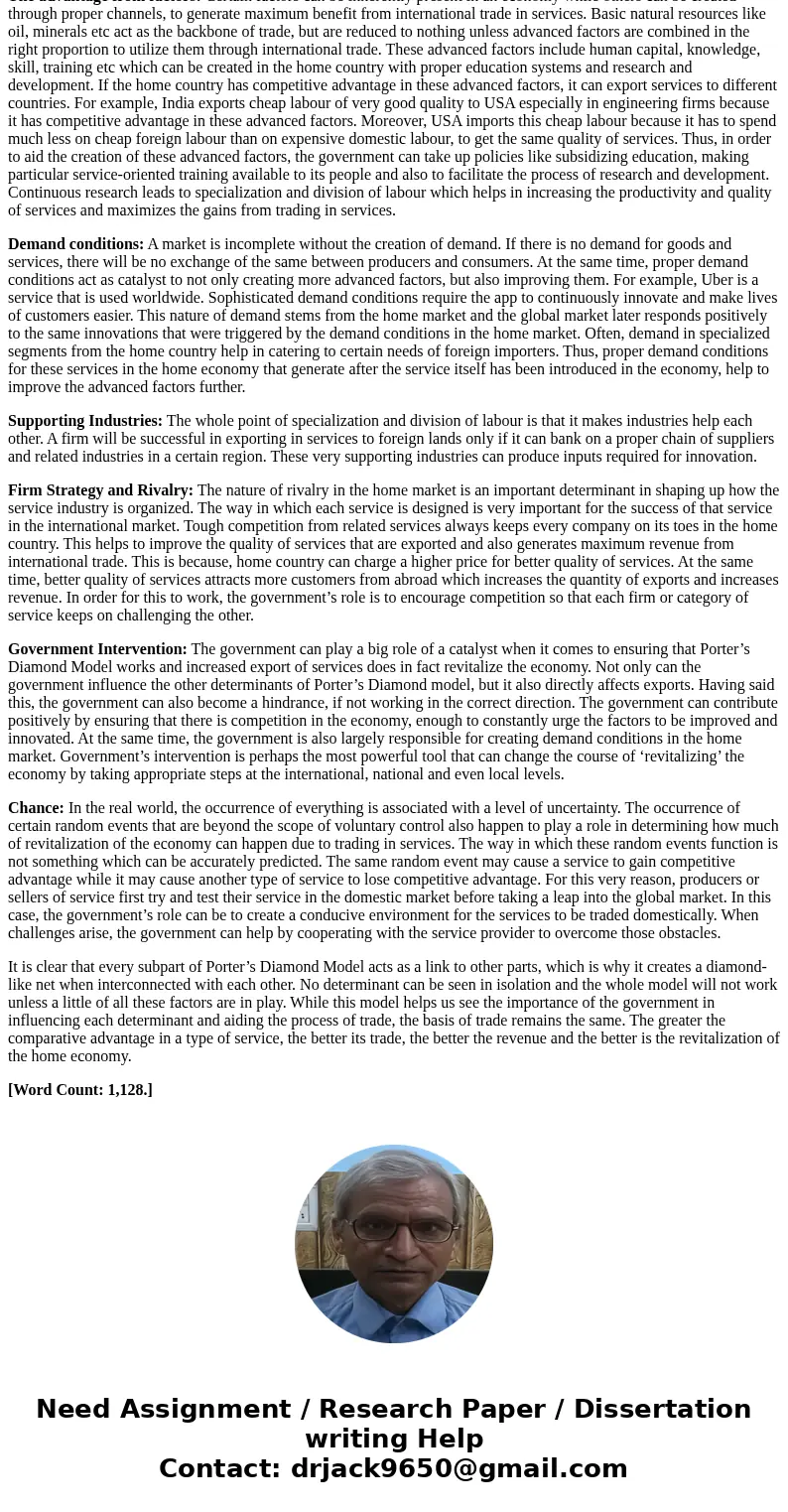Essaureporl areport about how international tradein Services
Solution
Whenever there is international trade among countries, it means that all the countries are benefitting from their trade-partners. Had that not been the case, then countries would not have signed up for the trade in the first place. International trade not only takes place in tangible goods, but also in intangible services. This trade can take place for various kinds of services like tourism, communications, information technology, etc. Just like trade in goods, trade in services also helps to revitalize the economy in one’s home town. This can be analysed with the help of Porter’s diamond model. This model helps to realize the competitive advantage that certain nations enjoy due to presence of certain factors. In addition, it also talks about how the government can aid the process of international trade through appropriate policy frameworks.
The advantage from factors: Certain factors can be inherently present in an economy while others can be created through proper channels, to generate maximum benefit from international trade in services. Basic natural resources like oil, minerals etc act as the backbone of trade, but are reduced to nothing unless advanced factors are combined in the right proportion to utilize them through international trade. These advanced factors include human capital, knowledge, skill, training etc which can be created in the home country with proper education systems and research and development. If the home country has competitive advantage in these advanced factors, it can export services to different countries. For example, India exports cheap labour of very good quality to USA especially in engineering firms because it has competitive advantage in these advanced factors. Moreover, USA imports this cheap labour because it has to spend much less on cheap foreign labour than on expensive domestic labour, to get the same quality of services. Thus, in order to aid the creation of these advanced factors, the government can take up policies like subsidizing education, making particular service-oriented training available to its people and also to facilitate the process of research and development. Continuous research leads to specialization and division of labour which helps in increasing the productivity and quality of services and maximizes the gains from trading in services.
Demand conditions: A market is incomplete without the creation of demand. If there is no demand for goods and services, there will be no exchange of the same between producers and consumers. At the same time, proper demand conditions act as catalyst to not only creating more advanced factors, but also improving them. For example, Uber is a service that is used worldwide. Sophisticated demand conditions require the app to continuously innovate and make lives of customers easier. This nature of demand stems from the home market and the global market later responds positively to the same innovations that were triggered by the demand conditions in the home market. Often, demand in specialized segments from the home country help in catering to certain needs of foreign importers. Thus, proper demand conditions for these services in the home economy that generate after the service itself has been introduced in the economy, help to improve the advanced factors further.
Supporting Industries: The whole point of specialization and division of labour is that it makes industries help each other. A firm will be successful in exporting in services to foreign lands only if it can bank on a proper chain of suppliers and related industries in a certain region. These very supporting industries can produce inputs required for innovation.
Firm Strategy and Rivalry: The nature of rivalry in the home market is an important determinant in shaping up how the service industry is organized. The way in which each service is designed is very important for the success of that service in the international market. Tough competition from related services always keeps every company on its toes in the home country. This helps to improve the quality of services that are exported and also generates maximum revenue from international trade. This is because, home country can charge a higher price for better quality of services. At the same time, better quality of services attracts more customers from abroad which increases the quantity of exports and increases revenue. In order for this to work, the government’s role is to encourage competition so that each firm or category of service keeps on challenging the other.
Government Intervention: The government can play a big role of a catalyst when it comes to ensuring that Porter’s Diamond Model works and increased export of services does in fact revitalize the economy. Not only can the government influence the other determinants of Porter’s Diamond model, but it also directly affects exports. Having said this, the government can also become a hindrance, if not working in the correct direction. The government can contribute positively by ensuring that there is competition in the economy, enough to constantly urge the factors to be improved and innovated. At the same time, the government is also largely responsible for creating demand conditions in the home market. Government’s intervention is perhaps the most powerful tool that can change the course of ‘revitalizing’ the economy by taking appropriate steps at the international, national and even local levels.
Chance: In the real world, the occurrence of everything is associated with a level of uncertainty. The occurrence of certain random events that are beyond the scope of voluntary control also happen to play a role in determining how much of revitalization of the economy can happen due to trading in services. The way in which these random events function is not something which can be accurately predicted. The same random event may cause a service to gain competitive advantage while it may cause another type of service to lose competitive advantage. For this very reason, producers or sellers of service first try and test their service in the domestic market before taking a leap into the global market. In this case, the government’s role can be to create a conducive environment for the services to be traded domestically. When challenges arise, the government can help by cooperating with the service provider to overcome those obstacles.
It is clear that every subpart of Porter’s Diamond Model acts as a link to other parts, which is why it creates a diamond-like net when interconnected with each other. No determinant can be seen in isolation and the whole model will not work unless a little of all these factors are in play. While this model helps us see the importance of the government in influencing each determinant and aiding the process of trade, the basis of trade remains the same. The greater the comparative advantage in a type of service, the better its trade, the better the revenue and the better is the revitalization of the home economy.
[Word Count: 1,128.]


 Homework Sourse
Homework Sourse